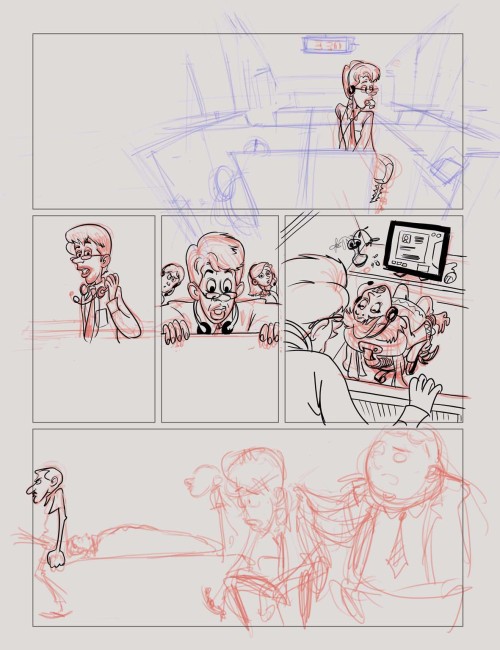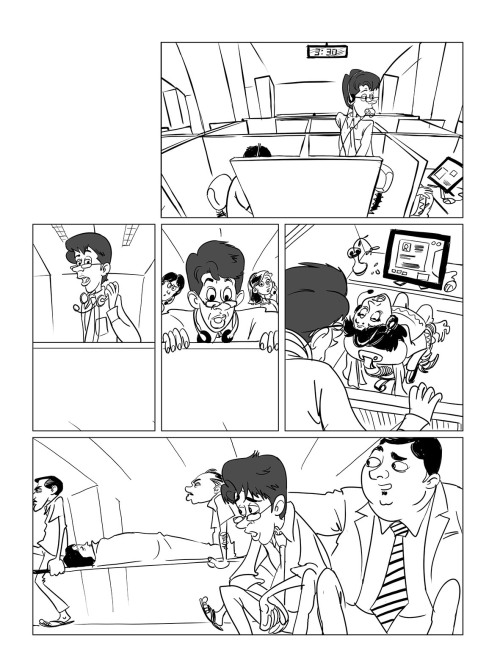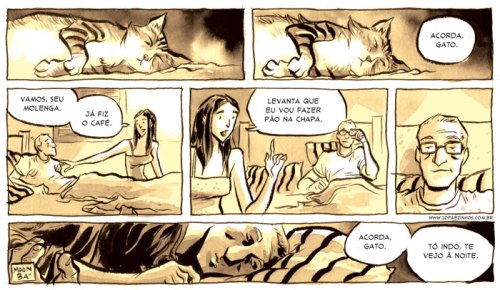Since I’ve been doing comics for a while now, and I haven’t been posting here much (although I have been posting very regularly on the Daily Fiction blog), I thought I’d do a process post how Nitin Veturkar and I create a comic.
Most of our comics before we started on the Kindle magazine gig were adaptations of prose stories I had already written (like this one and this one). There, Nitin did the adaptation, and I only gave him notes on his thumbnails, but left the rest up to him. Then I would edit the story for lettering (removing descriptive passages that were already presented by the artwork). With the Kindle gig, we are using the full-script method which is de rigueur in the comics industry.
This is Page 1 of the 4-page comic we’ve done for the October issue of Kindle Magazine (out in a couple of weeks – pliss to buy, True Believer). It’s called ‘The Suicide Artist’ (part of the basic concept was contributed by Trisha Ray).
Usually, I start with a very informal story-cum-treatment which is more about what happens than about how it happens. There’s very little description, a few bits of dialogue and zero formatting. This is just for me, my zero draft.
And then slowly, it turns into a script, with panel breakdowns, descriptions, dialogue, and after I’m done, I format it into a legible thing with two fonts – one for descriptions, and one for dialogue. It looks more or less thus:
PAGE 1 (5 panels)
Panel 1
The first row of the first page is split into two parts. The first part, covering around one-third of the width, is blank. The first panel covers the rest of the width – two-thirds of the page. The title and credits will go into the blank space.
TITLES: THE SUICIDE ARTIST
by Aditya Bidikar
& Nitin Veturkar
(with thanks to Trisha Ray)
Panel 1 is a wide panel. The top half is empty, except for a wall clock saying 3.30. Under the clock, covering the rest of the panel, we have a view of a line of office cubicles. There are, let’s say 4 cubicle areas visible in this panel – so there would be eight/six people sitting in them. Four in the foreground, four in the background. Let’s say the cubicle arrangement is as follows:
1 | 2 | 3 | 4 – background
5 | 6 | 7 | 8 – foreground
The people in seven of the cubicles are sitting. In this panel, we can only see one character. Basically, the person sitting in the right-most cubicle (cubicle 4) in the panel has gotten up and is trying to look into the cubicle beside him (i.e. the cubicle 8).
This is our hero. Clean-cut young man, around 22-23, works in a call centre. Probably wearing a tie. His name is Manik.
MANIK: Tina, the boss is asking for you.
MANIK (linked): He says you’ve been on a call for nearly 54 hours.
Panel 2
Smaller panel. Everyone else in the cubicles (except for Tina) has heard that and is now standing up and trying to look into Tina’s cubicle (cubicle 8).
MANIK: Tina?
Panel 3
Mostly the same as panel 2, except Manik is now leaning into Tina’s cubicle. He looks a bit shocked.
MANIK: Tina!!
Panel 4
We see a view of what Manik is seeing. A top view of Tina’s cubicle. A cubicle covered from three sides (left, bottom – where Manik is, and right). Sparse desk, a vase with flowers that have withered. The call control system in front, with the headphones on Tina’s head.
And finally Tina – who has been dead for three days. She is slumped on her office chair, with her head thrown back, looking at the ceiling. Her eyes are open, as is her mouth. She is wearing a salwar-kameez. And although she hasn’t started rotting yet, her skin has gone wrinkly and sunken. She looks a bit like an old woman, but she is very clearly dead.
(no dialogue)
Panel 5
This is a shot of a corridor. To the left, there is a set of chairs, and Manik is sitting on one of them. Beside him (on the other side from us) is his boss, who has a hand on Manik’s shoulder. In front of Manik, two ambulance attendants are wheeling out Tina’s body on a stretcher.
BOSS: I’m sorry, Manik. You and Tina were close, weren’t you?
I send this to Nitin, and to my editor and a couple of preliminary readers. By now, Nitin knows that this is less a set of instructions than a set of guidelines, and since I will be lettering the final comic, he can take a bit of freedom to frame and draw the panels while keeping the essence intact. Usually, we have already discussed the visual style he’ll be using. He sends me a set of thumbnails or pencil roughs, which look like this:

I give him my feedback regarding clarity and a few things that I think should be changed (usually very minimal), and then he sends me the actual artwork.

And then I letter it in a vector program, sometimes adjusting the script to fit the artwork. This time, to go with the cartoony style, I decided to use slightly more brushy balloons than usual, and thinner balloon tails to imitate newspaper comic-strip lettering. And then we get the finished page. Like so:

‘The Suicide Artist’ will appear in the October issue of Kindle Magazine.






